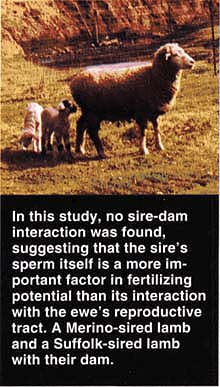All Issues
Is there a sire-dam interaction in sperm fertilizing potential?
Publication Information
California Agriculture 55(6):25-26. https://doi.org/10.3733/ca.v055n06p25
Published November 01, 2001
PDF | Citation | Permissions
Full text
TO optimize the efficiency of food animal production, a high level of reproductive efficiency is required because producers must spend a large proportion of their resources on the breeding herd. Previous research has demonstrated significant variation in the fertility of males. Our project was designed to evaluate whether there is a male-female interaction in the fertilizing potential of sheep sperm.
In this study, no sire-dam interaction was found, suggesting that the sire's sperm itself is a more important factor in fertilizing potential than its interaction with the ewe's reproductive tract. A Merino-sired lamb and a Suffolk-sired lamb with their dam.
The fertilizing potential of sperm is based on characteristics of the semen, or on the interaction of semen characteristics with those of the female reproductive tract, or both. To the extent that the fertilizing potential of sperm is based on the interaction with characteristics of the female reproductive tract, fertility is female-dependent (that is, there is a male-female interaction). These possibilities were tested by inseminating individual ewes with equal numbers of cryopreserved sperm from the same two rams in two consecutive breeding seasons.
Estrus was synchronized in five groups of approximately 30 Targhee-type white-faced ewes using progesterone-impregnated vaginal sponges. The ewes were inseminated with a mix of equal numbers of sperm from one of five different combinations of Merino and Suffolk rams. Ewes that lambed the first year were inseminated in the second year with the same combination of cryopreserved semen. The sire of each lamb was determined based on the coat color of the offspring's head and legs. The percentage of lambs sired by each male was determined for each semen combination using all lambs born to obtain an evaluation of the fertilizing potential of the two sources of sperm in each combination. Some ewes produced lambs sired only by the more fertile ram, and some gave birth to offspring sired only by the less fertile ram, or both. Ewes were divided into subgroups based on the sire or sires of lambs born the first year. The proportion of lambs sired by each male for these same ewes in the second breeding season was examined in the subgroups.
A total of 45 to 70 lambs (from 18 to 22 ewes) was born to each of the five combinations of sire semen. The more fertile semen in the combination produced 73% to 82% of the offspring. Twelve to 15 ewes in each of the five groups lambed twice to their respective semen combination. With a sireewe interaction, ewes conceiving to the more fertile semen the first year would be more likely (than the flock average) to conceive to that same semen the second year. Similarly, ewes conceiving to the less fertile semen the first year would be more likely to conceive to that same semen the second year. However, when ratios of lambs born the second year in the various subgroups were compared with ratios of lambs born the first year in those same subgroups, five of the 10 subgroups varied significantly (P < 0.01 to P < 0.001). The lack of a sire-ewe interaction in this study suggests that the factors influencing the fertilizing potential of sperm are specific to the sperm rather than to the interaction with the female reproductive tract.





